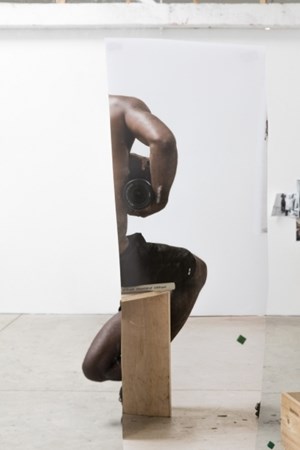
Taking place at the Grand Palais, Paris Photo is the largest international art fair dedicated to photographic art. This year, the event takes place from 9-12 November and brings together a diverse range of artists and galleries from around the world. Amongst the 180 galleries displaying work at Paris Photo is Yancey Richardson Gallery. Based in New York and founded in 1995, the gallery deals with fine art photography from the 20th century and contemporary artists. Amongst the artists they are displaying at this year’s Paris Photo is Paul Mpagi Sepuya, an American artist who explores the nature of relationship between artist and subject. Artdependence caught up with Paul Mpagi Sepuya to find out more about his work.
Taking place at the Grand Palais, Paris Photo is the largest international art fair dedicated to photographic art. This year, the event takes place from 9-12 November and brings together a diverse range of artists and galleries from around the world.
Amongst the 180 galleries displaying work at Paris Photo is Yancey Richardson Gallery. Based in New York and founded in 1995, the gallery deals with fine art photography from the 20th century and contemporary artists. Amongst the artists they are displaying at this year’s Paris Photo is Paul Mpagi Sepuya, an American artist who explores the nature of relationship between artist and subject. His works seem to offer an insight into the workings of a photographer’s studio and exude a certain eroticism and vulnerability.
Artdependence caught up with Paul Mpagi Sepuya to find out more about his work.
AD: There are many photographers whose works refer to the Dutch/Flemish painters of the Golden Age. Would you say that your work is inspired by the great sculptors of the past, such as Rodin?
Paul Mpagi Sepuya: There are some interesting photographs of Rodin’s studio, filled with completed sculptures, works in progress, models and himself presiding over it all - and those are interesting. But no, I’m not interested in his work per se, or that of his peers. What is of interest to me is the legacy created - the artist’s studio salon as a site of privileged looking, indulgence, and power dynamics within the gaze.
AD: Your work is homo erotic, maybe even uncomfortable viewing for a number of people. Is it your intention to be a frontrunner for the gay community? Is it still needed?
PMS: I’m not intending to be a frontrunner or to define a gay community by my work. My project is about insisting that the structures of queer eroticism are tied to the foundations and structures of photography’s practice and history. But I teach, and do studio visits, and am in communication with peers, younger artists and students. I am aware and embrace the fact that for many gay and black students my work and example is as a role model. I enjoy being a part of these conversations.
AD: You seem comfortable with the idea that through your work, the audience can look into your studio, like voyeurs. Would you consider yourself a voyeur?
PMS: The audience may think they are having a look into my studio, but they are not. It’s not documentation, but a very specific and controlled representation of parts and elements. The viewer is not free to wander with their eye unchecked, which voyeurism requires. Voyeurism is the pleasure of looking without the interruption of being seen. The repetition of the camera, of the portrait subject looking at the viewer, doesn’t allow for that.
I am not a voyeur but a participant.
AD: Do you like experimenting?
PMS: All of my work is an on-going learning process, and yes, that requires experimentation.
AD: Are the objects in the mirrors symbols with a deeper meaning?
PMS: There are no objects in the mirrors. There are the camera, tripod and/or myself and another person reflected by the mirror. The traces of fingerprints, bodies, residue of tape and adhesive, and dust from the studio on the surface of the mirror. And there are cut and torn prints taped and held onto the surface of the mirrors.
Study with Two Figures, N.B. and J.T., after R.N.B. (1404), 2015, 45 x 35 inch or 80 x 60 inch archival pigment print
AD: Your work has been shown in many major museums in the USA, but not yet in Europe. Why do you think that is?
PMS: In the mid 90s through 2000s I had much more support in Europe and Canada than in the US. From the zine and portrait work through to the beginnings of my project “Some Recent Pictures” which was photographed heavily in Paris, Barcelona and Copenhagen in 2012. Some of my first portraits were made in Vienna, Berlin and Copenhagen in 2006 and grew out of correspondences around my first project “Beloved Object & Amorous Subject.” I have only just begun being collected by museums in the US.
AD: What will you show at Paris Photo?
PMS: I don’t know! Whatever Yancey Richardson gallery is taking, I trust it will be a good selection.

ArtDependence Magazine is an international magazine covering all spheres of contemporary art, as well as modern and classical art.
ArtDependence features the latest art news, highlighting interviews with today’s most influential artists, galleries, curators, collectors, fair directors and individuals at the axis of the arts.
The magazine also covers series of articles and reviews on critical art events, new publications and other foremost happenings in the art world.
If you would like to submit events or editorial content to ArtDependence Magazine, please feel free to reach the magazine via the contact page.